Do you have a game plan for staying healthy this autumn and winter? Preventive wellness isn’t always all that sexy, but avoiding the endless cycle of sickness that can keep you down during these colder months is truly priceless!
I’m fond of saying that the best herbs for colds and the flu are the ones that help you prevent them! Luckily, with herbs and spices in your kitchen, staying healthy can be fun, delicious and easy.
I know that it’s the herbal habits and traditions you do every day that will be the most impactful for your health. With that in mind, I’ve formulated a delicious herbal wellness tea recipe that is perfect for savoring these crisp autumn months.
This tea isn’t just a pretty taste! In fact, it contains all five flavors of herbal medicine and can be used to support your immune system, provide deep nourishment and enhance your digestion.
Now, let’s take a look at what’s in this wellness tea recipe.

Pungent Taste: Cinnamon (Cinnamomum verum, C. burmanni)
The pungent taste is full of aromatic herbs that tend to be spicy and stimulating. We use them to promote healthy digestion and get things moving. Cinnamon is a deliciously aromatic spice that does all this wonderfully! It can improve digestion, regulate blood sugar, and is commonly used to treat various symptoms of both colds and the flu.
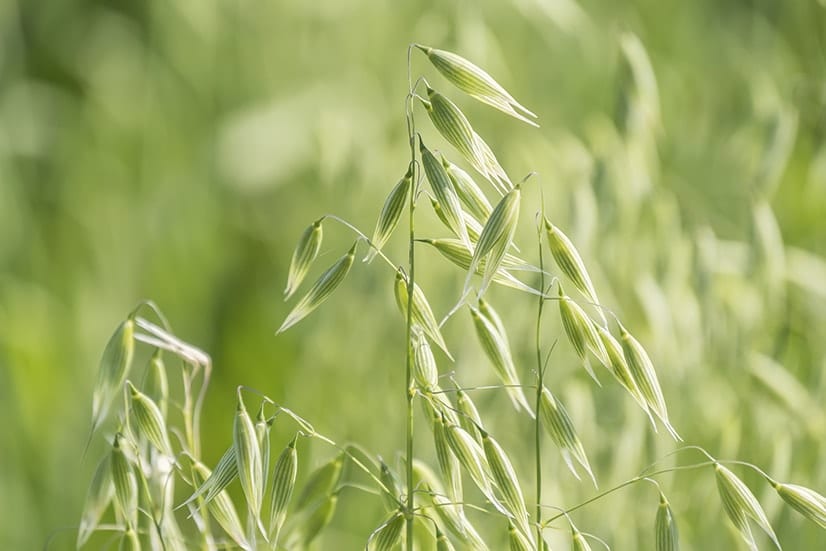
Salty Taste: Oatstraw (Avena sativa)
The salty taste often contains herbs that are deeply nourishing as these herbs are high in vitamins and minerals. While some salty herbs can taste like table salt (i.e., seaweed), most of these herbs have a dense mineral taste, kind of like kale. Oatstraw is one of my favorite nourishing herbs for the nervous system. Research has shown that chronic stress leads to inflammation, which is believed to make you more susceptible to illness, including the common cold.1
Regularly using herbs, like oatstraw, that nourish the nervous system can be one way to address chronic stress in your life.
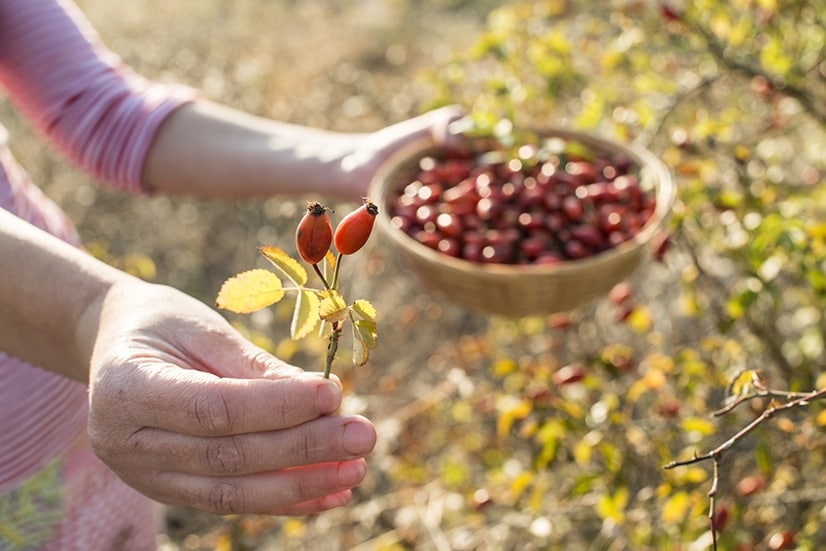
Sour Taste: Rose Hips (Rosa spp.)
Sour herbs are wonderful protectors. Often filled with antioxidants and flavonoids, these herbs are trusted allies for countering systemic inflammation and oxidative stress. Remember how chronic inflammation can lead you to getting more colds? Regularly eating herbs high in antioxidants can play an important role in modulating inflammation.
Rose hips have been the focus of several studies demonstrating their ability to modulate inflammation and decrease pain.2
To date, several studies have shown that the daily consumption of rose hips can reduce pain and improve general well-being in patients with osteoarthritis in the hips and knees and also benefit patients with rheumatoid arthritis.3 4 5 6

Bitter Taste: Dandelion (Taraxacum officinale)
The bitter taste is cooling and draining and is often used to stimulate digestion. Dandelion roots are both bitter and nourishing, something herbalist jim mcdonald calls a nutritive bitter. Dandelion root has a special affinity for the liver, helping to nourish and strengthen it. Considering the thousands of tasks your liver performs every day, keeping it happy is a powerful way to stay healthy.

Sweet Taste: Astragalus (Astragalus propinquus)
Our sweet tasting herbs rarely taste like honey, but often have just a hint of sweetness hiding within their complexity. Sweet herbs are often adaptogens and immunomodulators. Astragalus is one of my favorite examples! This rooty wonder broadly supports immune system function, helping you to be stronger and more resilient.
I used to get colds and the flu every year, but once I started regularly using astragalus, my frequent illnesses have been a thing of the past. Astragalus is also a wonderful herb for addressing long-standing fatigue. You get the best results with astragalus when you use it regularly and in food-like quantities.
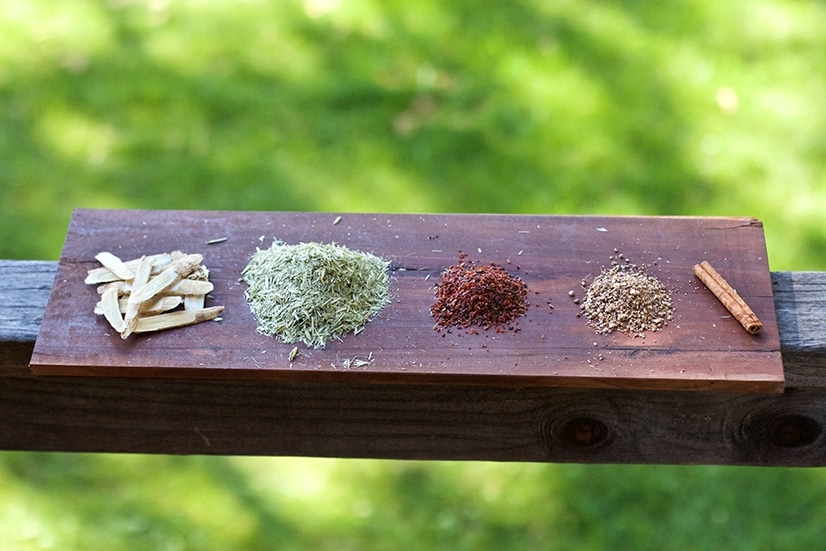
Five Flavored Autumn Wellness Tea Recipe
The seasons are changing, school is starting up and it’s time to take the reins of your health to prevent the colds and flu that are common in the winter months. This wellness tea recipe is a tasty way to provide deep nourishment, soothe your nervous system and broadly support your immune system. For best results, enjoy regularly.
What you’ll need…
- 15 grams dried astragalus (or small handful of sliced roots)
- 10 grams dried oatstraw (1/3 cup finely sifted)
- 10 grams dried de-seeded rose hips (1 tablespoon)
- 10 grams dried roasted dandelion root (1 tablespoon)
- 3 grams dried cinnamon chips or 1 cinnamon stick broken into pieces
- 4 cups water
- 1 cup apple juice

- Place the herbs and water into a medium saucepan.
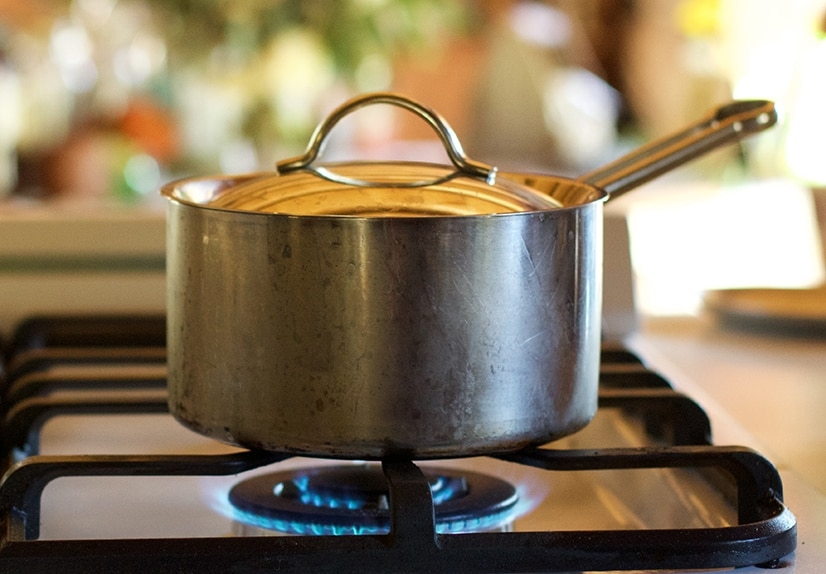
- Bring to a boil and then reduce the heat and simmer for 30 minutes, covered.
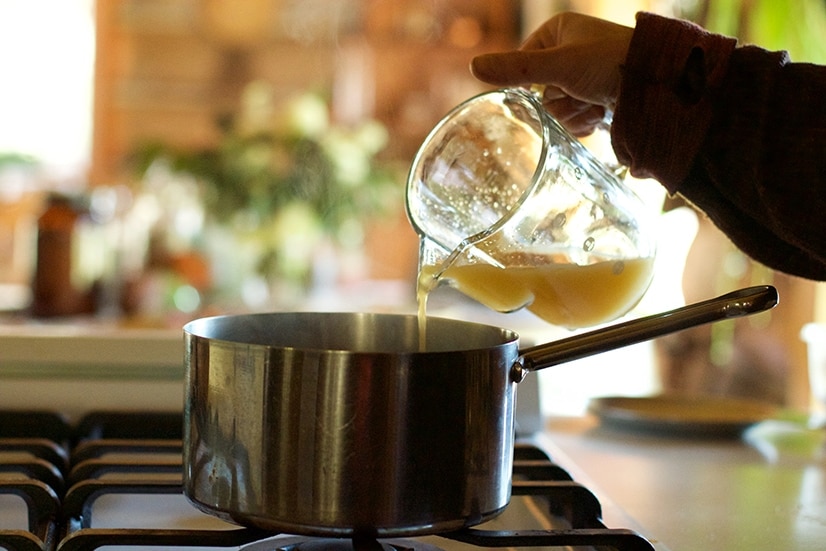
- Turn off the heat and add the apple juice. Let stand 5 minutes.
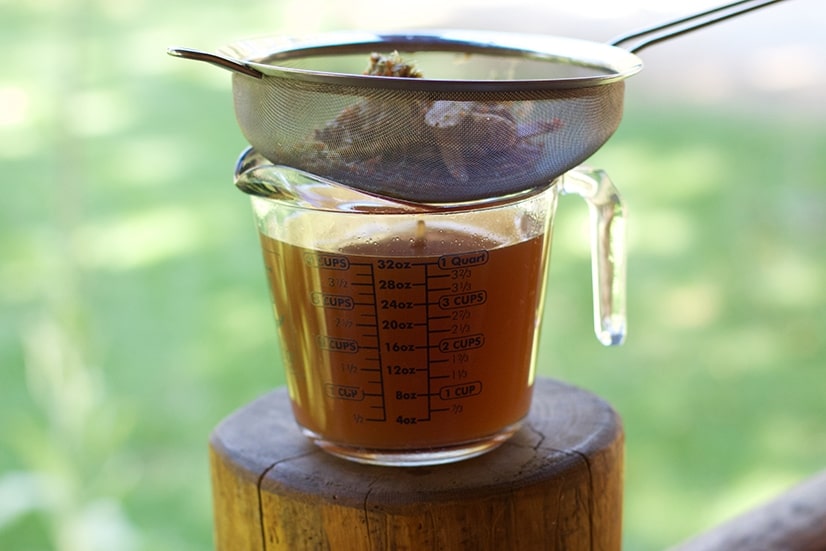
- Strain.
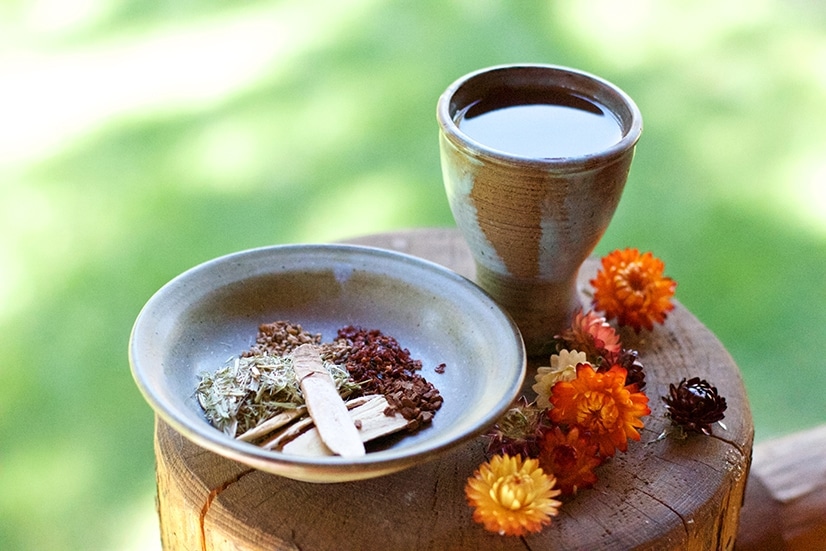
- Drink warm or cold as desired. (I prefer warm!) Drink within 48 hours.
Yield: 4 cups
Now I’d love to hear from you!
What do you do this time of year to bolster your immune system for the coming months?
Let me know in the comments below.

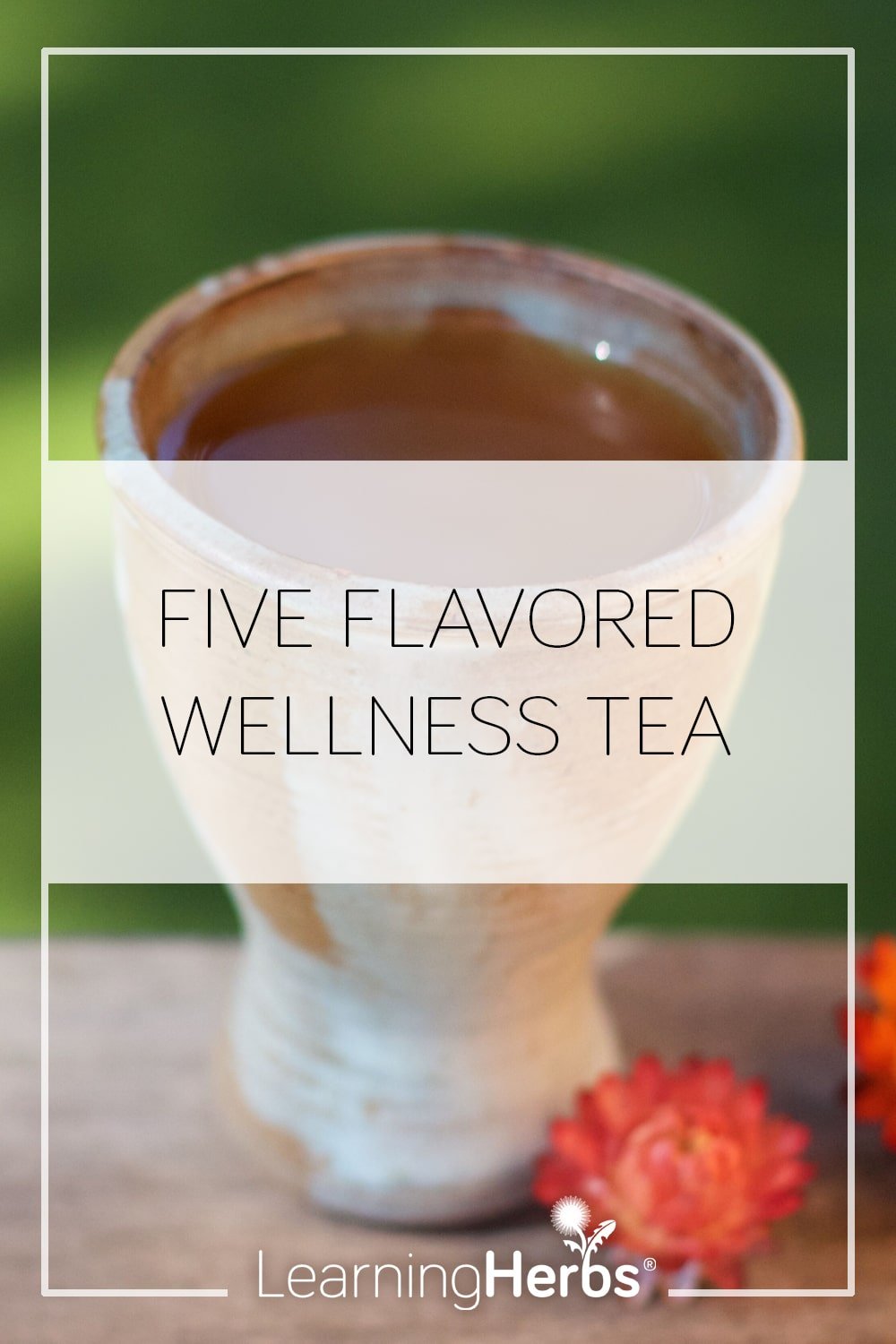


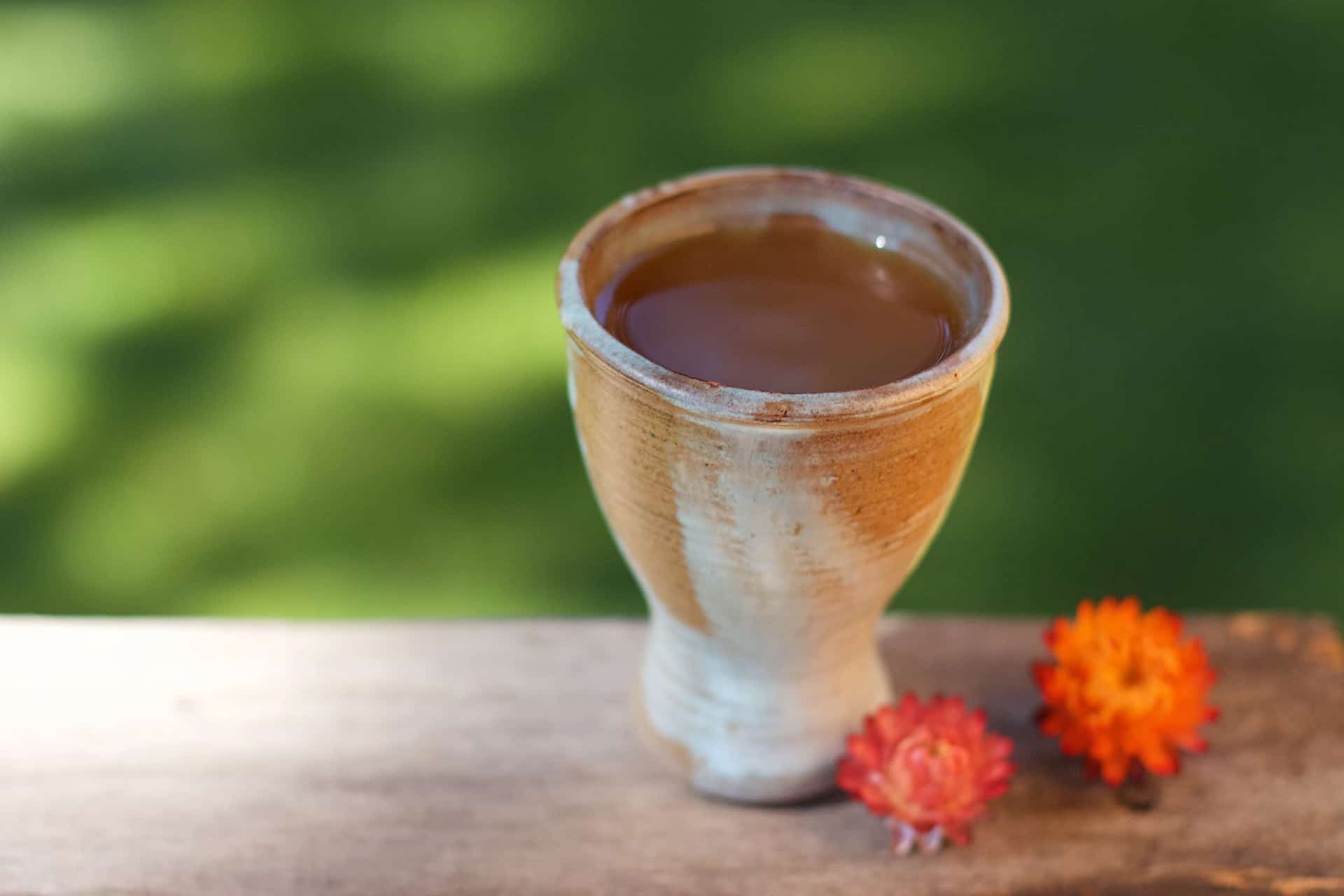
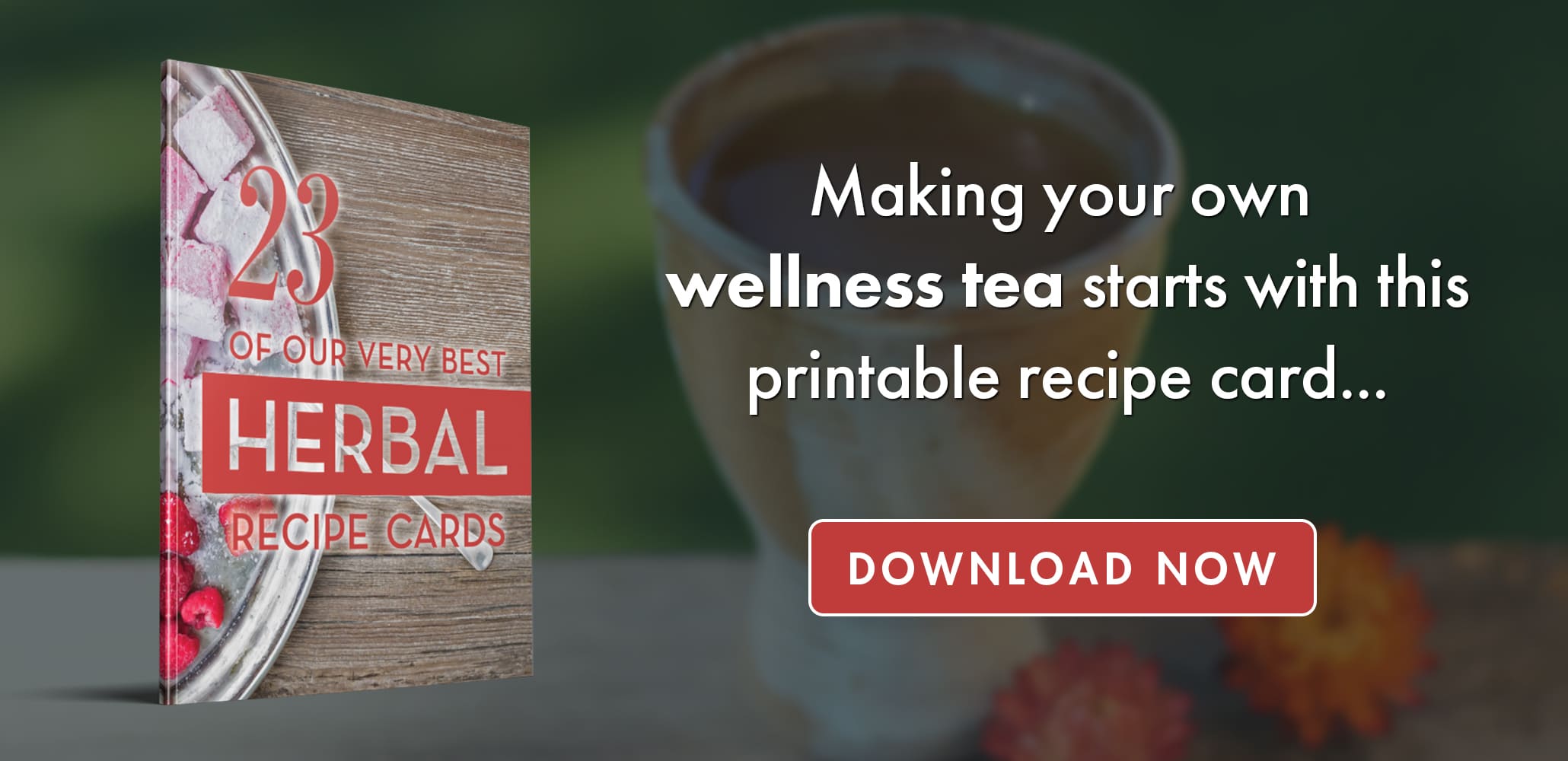






Sounds great! Would you be able to substitute apple cider for the apple juice (apple cider is my quintessential fall drink!)?
The definition of different apple beverages is nuanced and varied! Here’s my definitions (which are admittedly more of a European slant):
Apple Juice: Juice pressed from apples, either sold as shelf stable or is freshly pressed and unfiltered.
Apple Cider: Fermented apple juice, sometimes called hard cider in the US
Apple Concentrate: Syrup or powder that has been reconstituted into a beverage.
I used to refer to apple juice as apple cider in my recipes. A strange thing often happened though. Herbalists just filled in apple cider to be apple cider vinegar. I specifically remember getting a lot of complaints about my elderberry gummy recipe being unpalatable and too sour, and then finally figured out what was happening.
To get to the point, I’m guessing you are wondering if fresh pressed unfiltered apple juice can be used for this recipe, the answer is yes.
Rosalee, this is amazing. Tasty and I took it during rounds of stomach flu and was able to avoid catching it. I love this recipe. Tastes like a declicious apple cider. Replaced dandelion root with the leaf. Same amount. I also had heard about oatstraw being an iron clad nervine. Despite drinking nourishing herbal infusions of this daily but in a rotation, al la Susan weeds recommendations, I just wasn’t feeling it. Well guess what? Cooked oatstraw packs a potent punch for me. I would never have known this if it weren’t for this recipe. At the first sip I literally felt all of my muscles relaxing and felt totally calm. Incredible! Thank you!
Good day. Using the Wheel of Wonder, can I substitute the herbs I do not have on hand at the moment (or those that do not agree with member’s of my family’s constitutions) for others in their flavor family? Nettles for Oatstraw? Elder- or other berry for Rosehips? Angelica for Dandelion Root? Just picked up my first batch of apple cider and am looking forward to trying new recipes with it :)
As a visual learner I love both of th wheels you have created and I thank you. Looking forward to video 2!
Every herb has its own unique gifts. While substituting herbs is common practice, it’s hard to give a broad statement in terms of how to substitute. For example, both nettles and oatstraw are nutrient dense and are used to support healthy bones and teeth. But nettles can be used to address seasonal allergies (and as far as I know oatstraw isn’t) and oatstraw is used to nourish the nervous system (which isn’t necessarily something nettles would do).
I considered using elderberries instead of rose hips for this recipe. Again, two entirely different plants with different uses though.
Angelica would taste very different (and very strong) in this recipe. You could try it… but I wouldn’t consider it a substitute for dandelion.
Thank you for your quick reply, much appreciated. Fortunately, in this case at least, autumn is my allergy season – so nettles it is :) I’m glad you chose rose hips since all recipes are elderberry heavy this time of year – but, I am awaiting my buds arrival by mail. I have an elixir of calendula and orange peel that I’ll add after brewing, if need be, and skip the dandelion root for now. Enjoyable afternoon experiment if nothing else.
Thanks again.
We cannot get half the ingredients you ask for in your recipe for well ness tea. To buy it from your sponsored shop will be too expensive and too long to wait for. Whilst we appreciate your good intentions, you have to be practical, and consider that not everybody knows where to find astralagus, oatstraw and rosehips at this time of year, without a real shlep.
Hi Phil,
The herbs in the recipe are all very common in herbalism. While you can easily order them from Mountain Rose Herbs, you can also try sourcing these at a natural grocery store or look for local herb farmers. The town closest to me has less than 1,000 people and I can get all of these ingredients at the health food store there. Because I use these herbs regularly, especially at this time of year, I like to keep a good supply on hand.
This is like an advanced hot apple cider drink. I grow stevia so I would probably use that instead of astragalus and apple juice for sweetness. This time of year I take a lot of vitamin C and will blend 6-8 chewable C in a little hot water and add them to my kefir smoothies. To get my family to relax and go to sleep better I switch between Cedarwood, and Cloves and Lavender Essential Oils in my diffuser and sometimes on my furnace filter. I also grew lemon balm this year and saved a good amount of leaves in a ziplock bag in my freezer to make fresh tea over winter. I dried some too but read that they lose their oil when they are dried.
Thank you! Are there any side effects to any of these herbs?
Hi Pamella, These are all food like herbs that are considered to be generally safe. Any negative effects are mild and rare.
However, if you have any special medical concerns then I suggest either researching every herb you take thoroughly, or working with an herbal practitioner to help better understand how the herbs may affect you.
Thank you! Just what I have been looking for, an extra branch for my wellness tree. I started just last year making my own concoctions especially elderberry syrup and tincture. I hope I’ll be able to buy some elderberries because I was only able wild harvest a small amount.
What a great recipe Rosalee! Thank you:) I am inspired to go and dig some dandelion roots to roast:) For those who think the ingredients are too hard to find, you can order all of them from Mountain Rose Herbs [ and get a siz
able discount for being a Learning Herbs member]. If you order a quantity of each you will be able to make this wonderful tea all winter!!!
It’s lovely to hear from you Jane and I am ever so happy to inspire dandelion digging. :)
I’m looking at buying cinnamon chips but there are two options, cassia and sweet. Which would you recommend?
Hi Kim, the more common cinnamon in America is the sweet option. I have both and tend to use the cassia for herbal preparations and for more savory dishes. You can use either one.
Interesting, since I have read and heard from many teachers that cassia causes inflamation big-time. Which I suppose is why it’s half the price of the true cinnamon. I would research this before deciding to use it.
This is very helpful and educational-thank you. Have you addressed indigestion/GERD yet? I take a proton inhibitor and would love to begin learning about the herbal choices that could help. Thanks again
Hello Donna,
Here is a link to Rosalee’s site where you can begin your journey: https://www.herbalremediesadvice.org/index-of-diseases.html
I’ve linked you to a general health page and after you read it, you’ll see a LOT of links at the bottom. There are 5 articles for the digestive system. I hope this helps!
I want to try this wellness tea recipe. I have all the ingredients but oatstraw. Could you suggest a substitute?
Every herb has its own unique gifts. While substituting herbs is common practice, it’s hard to give a suitable substitute for this recipe. You can just leave it out. Oatstraw is in the “salty” taste, but every herb in that taste classification with have a different flavor effect in the recipe.
This looks so good! I’m hoping for a box of herbs for Christmas this year and if so, then I’ll have the astragalus needed. I think this will be a lovely Christmas day drink to share with my family! Then I’ll also have a homemade tea blend for our New Year’s tea party! I know it’s September but now it feels like Christmas!
Thank you, Rosalee. Is this recipe appropriate for kids? I have elementary school-aged kids. Also, I have all the ingredients but oatstraw. Do you have a recommended substitute? Thank you! Looking forward to making this.
This recipe is perfect for kids! I never got around to saying it, but I had kids in mind when creating it. :)
I highly recommend using the oatstraw but if you don’t have it, you can just omit it.
Hi- I was wondering if there was an equivalent substitution for astralagus? I don’t react well to it, but would love to have the properties!!
Have you tried Codonopsis pilosula? It has a lot of the same beneficial qualities, including a sweetish taste.
Thank you for the recipe. Before seeing this post, I made my own tea concoction this morning from my herb garden. The tea contained everything except the oat straw which I will first try to find in my local health food store. I have a question regarding the dandelion. I dehydrate my whole dandelion plants, is it necessary to roast the dandelion root? If so why? I just added a fresh whole young plant in my tea. Is this not the way to handle dandelion? I am new with consuming this plant.
Roasting the root gives it a different flavor – it tempers the bitterness and gives a rich taste. Dandelion roots are also quite cooling and roasting them warms it up a bit. You can leave it raw if you’d like though.
I like to chop up roots before I dry them. This makes them easier to use later as whole dried roots can be difficult to chop up into small pieces. Just thought I would mention that in case it’s helpful for you.
Would this tea taste ok without the apple juice or should I add some honey to it?
I think it would taste just fine without the juice. Give it a try and see what you think or if you think it needs honey.
Rosalee you are one of the most amazing herbal teachers on the planet today!! I love the grace and care that you give in sharing your expansive knowledge with so many people to make a difference in their quality of life!! Thank you!
Awww, thanks Amina!
Rosalee…
by your fault i am now a Western Herb addict !
OH for sure the wholesale where i bought tons of herbs (for real) is happy and in fact would love to meet you, but me.. ME, Rosalee! you changed my life instantly, with your lovely videos with John, your sweet way of instructing me on herbs and how a simple Astragalus Chai could change Quebec Winter’s coldness impact on — on who ? ME!
YOU, Rosalee, you did that!
And now i am HOOKED — waiting to see your next class (Taste of Herbs seems to be ON soon ! :) )
—
All that said, where can i learn more about recipes.
meaning, i will see the volume recipes as use two parts of this, one part of that
but where do you learn on which of which first and has the most ?!
and in this case, it’s 15gr of Astragalus but then the next 3 ingredients are 10gr the last one 3gr
is there a book in which i can find the proper quantity for X herb in a recipe ?
I understand that probably the Taste of Herbs class will show more about that as tasting herbs will give me an idea of which is good with this one and this one… but is there a class or book on the how much and when ?
thanks again for your way of seeing and teaching herbs.
Very nice and refreshing !
thanks to John and the team as well !!!
Jo
Hi Jo! Thank you for the compliments for Rosalee, John, and the rest of the LearningHerbs team. Do you have Rosalee’s book Alchemy of Herbs? There is quite a bit that goes into creating formulas. Here is a link to Rosalee’s Herbal Bookshelf for inspiration:
https://www.herbalremediesadvice.org/herbal-medicine-books.html
The best course is Taste of Herbs! You’ll learn so much about how to choose herbs for the person and Rosalee provides a lot of recipes for you!
Thanks for that sweet enthusiasm Jo!
Dosage can be a tricky thing in herbalism. Sometimes you want to strictly consider what a therapeutic dose of an herb may be, other times you want to factor in how it tastes too!
Any book with a clinical focus will include dosage suggestions. Keep in mind that herbalists rarely agree on anything, so dosage will vary with the author. In general Ayurveda and Chinese Medicine use larger dosages than western herbalists. As Karin said, I do include dosages in the Taste of Herbs course. :)
Thanks again!
Thank you for this recipe! My daughters & I have tea time in the afternoons where we enjoy poetry or a favorite read aloud together. I’m excited to add this into our tea recipe rotation!
Quick question- do you have a substitute suggestion for the oatstraw? My youngest has been on the AIP diet for a couple years now & although I’ve been able to add some foods back in, oats is not one of them. I’d love to add an herb that gives the “salty” element to the tea.
Thank you!
Every herb has its own unique gifts. While substituting herbs is common practice, it’s hard to give a suitable substitute for this recipe. You can just leave it out. Oatstraw is in the “salty” taste, but every herb in that taste classification will have a different flavor effect in the recipe. You could certainly try nettles or another “salty” herb. Check out the flavor wheel above.
You could try red clover. I haven’t used that in this recipe, but it just popped into my head as something worth experimenting with.
Thank you!
Hi! This sounds wonderful! One question, why de-seed the rose hips? I typically keep dried whole rosehips on hand and don’t think I’ve ever run across this before. Also not sure how I would go about it since the dried ones are quite hard.
If you have whole dried rose hips there’s no need to de-seed them for this recipe. However you might want to increase the amount you use.
I like to de-seed fresh rose hips and add them to honey or soups. That way you just get the fruit and avoid the irritating hairs.
You can easily buy de-seeded rosehips which is what I used in this recipe.
Thank you, interesting recipe, I will be happy to try it.
Re locating ingredients. With all due respect Not all small towns (even those that actually have so called health food stores) have places where herbs are available. I would have to drive well over an hour to get into a large city to find my “local” supply, and I cannot drive. And while Mountain Rose Herbs is a wonderful website full of excellent information and I have no doubt wonderful products they truly have no interest in servicing the international community and have made the cost of shipping outside of the U.S. so obscenely high I cannot imagine that anyone living in another country orders from them. (And since I do a Lot of cross border shopping and Know much lower/better rates Are Available I have to presume this was their objective.) Please remember your readers are from all over and may NOT enjoy the luxuries at your disposal, and that your recommended website is Far from a good choice for many.
For those living in Canada I can recommend the websites Organic Matters, and Botanic Planet. (Both ship to the States as well.) They both stock all the items called for in this recipe and I have been buying herbs from them for a few years now. Before I found them I too was at a loss since not only were many herbs impossible to buy but buying in large quantities was beyond cost prohibitive!
Hope this helps some people!
Thank you for sharing the Canadian resources with everyone!
We do strive to use the more common herbs in our recipes. As you might imagine, it is impossible to do that and cover the entire globe.
If you are interested, we have many free resources right on our site here. You can use the search field in the upper right to find articles of interest to you.
The recipe is quite delicious, so I hope you try it out!
I’ve been looking for a new way to incorporate prevention that the child will love! Adding the apple juice will incorporate the perfect amount of sweet (and vitamins) to make him happy! Elderberry gummies in the morning before school, applicious wellness tea after school and before bed (warm) for additional wall of herbal defense!
As usual, you rock, thank you!
my hubby is in great pain from arthritis and multiple surgeries on back knees and shrapnel that is in the back of his body including his head. They stopped giving him pain meds and now he has become addicted to street meds including derivatives of cocaine. What can i do for him? What can i give him that will take away the edge off the pain and make him feel better. I can tell you he is hot…but not sure of the rest. Please help me help him.
I’m so sorry to hear about your husband’s health. The best thing you can do is connect him with an herbalist one-on-one. One resource for finding an herbalist is the American Herbalists Guild directory. Some herbalists will do long-distance consultations. http://www.americanherbalistsguild.com/member-profiles
Best wishes!
thankyou for sharing I cannot wait to try this ,however with rose-hips how do you de-seed them?Especially dried rose hips .
If you have whole dried rose hips, there’s no need to de-seed them for this recipe. I myself used whole rosehips that I dried. I measured by weight and would still go a bit higher to balance the sour taste into the whole flavor profile. It is very tasty, so I hope you give it a try!
That’s the cutest cup ever for giving a shot of wellness :-) Care to share where you got it? Love this recipe and everything you do…can’t wait to make it!!
I love that cup too! I got it at the thrift store and it’s signed at the bottom so I’m guessing it was hand made.
Personally, I would make 1 change to the recipe. Either I would substitute the Rosehips with Elderberries or I would make a separate cold infusion with the Rosehips and then add it to the rest. One of the main reasons for using Rosehips is that they are so extremely high in Vitamin C! But Vitamin C is also extremely sensitive to HEAT. Heat destroys the Vitamin C. So I always, always make a cold infusion with Rosehips so I don’t damage or eliminate the Vitamin C. Boiling the Rosehips would destroy the Vitamin C content in them. So, either add Elderberries to replace the Rosehips, or make a separate cold infusion you can add to the rest when it’s done boiling and cooled enough.
Hi Alisha,
Elderberries are so wonderful! I considered using them for this recipe, but obviously decided to go with rosehips instead. Did you know that elderberries are also high in vitamin C? You’re right, vitamin C is very volatile. In addition to heat, it also diminishes with drying. I’ve even read that 24 hours after you pick a strawberry, much of the vitamin C is gone. I still love strawberries that were picked yesterday. I even love strawberry jam, which probably has very little vitamin C.
There’s so many wonderful properties in both rosehips and elderberries. Both strongly modulate inflammation for example. Many of these qualities continue after the plant is dried and even after it is simmered.
As you pointed out, I wouldn’t rely on this recipe to supply a high source of vitamin C. Truly, the best way to get vitamin C is to regularly eat freshly picked foods that are high in Vitamin C.
Thank you Rosalee for this healthy tea, which I would like to try, this is about dandelion root – could it be substituted with burdock root, if can’t get hold of it, and could this also be roasted?
Burdock root would be a great substitution and you could roast it. Enjoy!
Hello All. Loving all the questions and answers. My first question was answered above re: children my second is quantity. Can my Granddaughter, just on 2, have more than 1 cup a day. Many Thanks.
A cup is probably plenty for a young child. When my daughter was that young, she would get bored with a tea or drink long before 8 ounces. I let her self-regulate. Enjoy!
I make chicken soup with lots of garlic and rosemary. Sometimes I sneak some stinging nettle into it. I also like to use dandelion greens. So good!
I only have powdered rose hip seed at the moment. Okay to use as long as it’s strained with cheese cloth? Would I use less? Or the same amount?
For this recipe, I would skip the powder. You can leave the rosehips out or you could try elderberries or another “sour taste” herb. If you substitute, the flavor will be different. Let us know how it goes!
Hello all! I was wondering if anyone would share directions for roasting roots?? Would love to give it a try, but am clueless as to how to go about it! Do different roots need different times and temps? How should roots be pepped for roasting? And if one is using their oven as a means of drying their roots, can you accidently roast them? Sorry to be the “font of questions” but any help would be sincerely appreciated! Thank you!!!
You’re in luck! Rosalee has a step by step guide to harvesting and roasting dandelion roots here: https://learningherbs.com/remedies-recipes/dandelion-root/
You can use the same process for roasting other roots like burdock and chicory, too.
Astragalus can sometimes raise blood pressure in higher doses. Is this safe for someone with high blood pressure?
P.S. I accidentally ordered “Dandelion Root” on Mt. Rose Herbs instead of Roasted. Does this effect the recipe in any way?
Can i make a large batch and freeze the remaining amount? . Will it still be potent when defrosted and consumed ? And is this safe for a 5 yo child to drink daily?
When I weigh the rosehips and dandelion root 10g seems like much more than 1 TBSP. Is this weight correct? It’s a new scale with new batteries. Thank you.